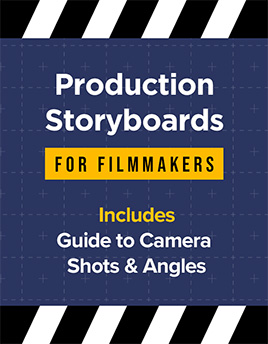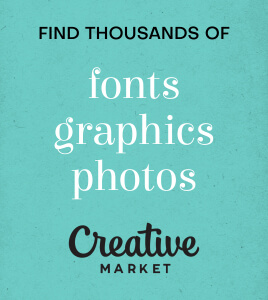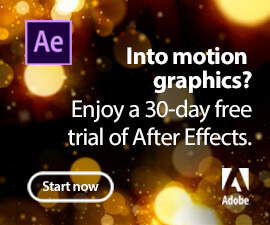
Image Source : Parallax Corporate Promo
Perfect for beginners, handy for professionals
Whether you’re a seasoned motion graphics designer or just starting out in video production After Effects templates are enormously helpful in getting the job done quickly.
Using an After Effects template will cut out hours, if not days, of legwork – for the price of dinner!
After Effects’ professionals can utilize these time-saving projects to speed up their work rate, or perhaps explore some new techniques. As ‘source’ files, these projects can often be totally deconstructed, revealing magical expressions and keyframe trickery. Handy, also, for those with an beginner’s interest in motion graphics and video production.
If time is of the essence or you need some inspirational motion graphics techniques take a moment to see what ready-made After Effects templates have to offer and read our 5 Steps to After Effects templates.
Try After Effects for Free
Use the link below to access a trial version of Adobe’s incredible motion graphics software.
Try After Effects for free!Step 1 : Choice
So many templates to choose from
It’s vital that you decide on the purpose of your final video.
Attracting new customers? Branding your video content? Promoting a product?
Many templates simply provide interesting and unique ways of displaying a set of images (photo slideshows) whereas other templates contain independent animated graphical elements to overlay your existing video footage (lower thirds, infographics).
Don’t get too distracted by whizzy particle effects! Move away from the computer for half an hour – write down your intentions in as much detail as possible.
Are you creating a photo slideshow, a corporate presentation, a simple logo branding introduction – perhaps even a movie title sequence?
Sites such as Enchanted Media will filter the ‘function’ of a template on the top level navigation, leaving the search facility to narrow down on visual style.
Your first contact with After Effects templates will be their video previews. These are meant to show off the templates’ visual appeal, fully rendered with example text, images, logo and music. There are hundreds of templates available online, within each function category, so finding the right one for your project can seem a little daunting at first.
Select a template and play the preview. Would this work with your own (message) text, imagery and music?
Take a moment, try a few – you’ll save plenty of time in the long run by starting with a template.
And, also bear in mind that a change in font, imagery and music can dramatically alter an After Effects template into something quite different.
Whatever your final goal you will eventually need to open up the After Effects file and edit the existing placeholders! Thankfully editing this content is an extremely easy process.
Step 2 : COMPATIBILITY
Be sure you can use it before you buy!
Before we talk about editing your newly found template take a moment to make sure it’s not concealing any hidden pitfalls!
Version
Thankfully After Effects files are cross compatible between Mac and PC, but the same cannot be said between Adobe’s versions of its own software! Generally speaking After Effects will not be able to open templates created in newer versions of itself. If you only have After Effects CS5 you will not be able to use templates created in CS5.5 or newer.
If you’re running the latest CC version you should have no problems opening all available templates.
Plugins
When choosing a template check that the project doesn’t require plugins. Plugins are third-party effects generators which can often cost many times the value of the template itself.
Although not a ruse by the template author to sell the plugin software (plugins can produce very powerful visual effects which After Effects’ own effect library cannot achieve) guidance should be contained with the template’s description on whether plugins are required to successfully produce a render from the project.
Licenses
Watch the license wording on different marketplaces as some have strict usage clauses (notably VideoHive) meaning you may not be able to re-utilize the template without first purchasing another license. The projects on Enchanted Media all have a simple Buy Once license, which means you can export as many sequences as you want – handy if you really want to milk those templates!
Step 3 : Customization
Making it your own
First, carefully read through the project’s User Guide/Read Me. This will provide an overview of where to place your media and how to edit text placeholders.
Great templates are meticulously organised so text and images can be added quickly and easily. You should find a well structured, tidy Project Panel where the compositions and elements to be edited are clearly separate from those which shouldn’t touched.
It’s at this stage where you put your own mark on the project. Editing text is a given, but you can normally change font and text size as well as colour to really personalise the video as your own.
Simply changing the fonts (size and colour) and images can dramatically alter the tone of a sequence, so it’s worth experimenting with a project to see if there are more applications it could be used for.
Global colour adjustment
For larger projects it is common to find a single point (usually a single layer) where the global colour values can be changed – common colours which run throughout the sequence. This avoids any unnecessary or accidental changes of elements which should be left alone.
Further guidance
If you need more help and understanding about using After Effects templates Phil Ebiner at Udemy.com offers a free course in template editing here.
Video Source : Video School Online
Step 4 : Audio
Finding music and sound effects that complement your video
Much like font and image changes the music choice can provide a powerful way of altering a project’s tone. A jolly sequence of titles can be transformed into an edgy thriller by simply changing the music.
Pond5 offers a huge range of music tracks and sound effects, specifically suited for video production and animation.
Search great music tracks on Pond5Step 5 : Output
Rendering and encoding your final sequence
Once you’re done with content and music choice the final thing to do is render your video. Unlike the rendering of video footage, templates are relatively short in length (titles, credits or short promotional animations). That said, After Effects can take up a lot of processing power to do its work.
If the project uses many effects a full render may take some time (several hours), so you may initially want to perform a Draft Render. This will produce a low quality video as it ignores motion blur and smoothing, though it’s usually good enough for you to check your content is all in place – and a good time do a visual spell check!
Once you’re happy that the content is correct you can perform a full render, using Best Settings. Typically I will render “Lossless with Audio” (choose Lossless from the Output Module then click the Audio Output checkbox). This will probably result in a large file (several Gigabytes) but is perfect as an intermediate format, ready for encoding.
Encoding for delivery
If you’re putting your video up online you’ll need to encode it first.
Gone are the days where we had to create several encoded versions, each trial and error on whether they would work well on Mac and PC platforms or, indeed whether the encoder would perform the task successfully at all!
Nowadays you can safely throw your Lossless render into Handbrake.
It’s free, it’s quick and it’s cross platform! Handbrake pumps out great quality MPEG4 files (from your Lossless render) in no time. MPEG4 seems to be universally accepted as a delivery format for web.
Get HandbrakeThat’s it for our After Effects template guide today. Why not go ahead and browse some great quality templates right now at Enchanted Media.
Browse After Effects TemplatesShare with someone!
GLOSSARY OF TERMS
A glossary of some common terms used when discussing After Effects templates.
Composition – a single working space, like a single Photoshop canvas, to visually compose media and effects. Each composition has its own Timeline.
Draft Render – a handy render setting for outputting video test sequences quickly. Draft settings ignore motion blur, image smoothing and result in lower resolution renders.
Expressions – pieces of code which can connect elements and effects together allowing for complex animations from simple controls.
License – an agreement for the permitted usage of (in this case) digital files.
Lossless – an uncompressed video file, usually of significant file size, which retains the level of the quality set at its production.
Lossy (compression) – the degenerative encoding of a video file to reduce its file size and make it more suitable for smooth playback, especially when delivered online.
Markers – indicators within the Timeline of a project which, when commented, give precise usage guidance to the end user.
Project Panel – an area in the After Effects application window (usually top left) which contains links to every internal and external asset contained within a project. This is the area where external assets (e.g. images or video clips) are imported and where internal assets (e.g. new compositions) are created.
Plugins – third-party software add-ons which provide additional effects and functionality to After Effects.
Render Queue – a window within After Effects where compositions are placed for output. Settings are adjusted in this window to instruct the dimensions, resolution and compression of an output video sequence.
Timeline – the main working panel (usually situated at the bottom) of a composition sequence where assets layers are stacked and temporal animation keyframes are set.
Share with someone!








